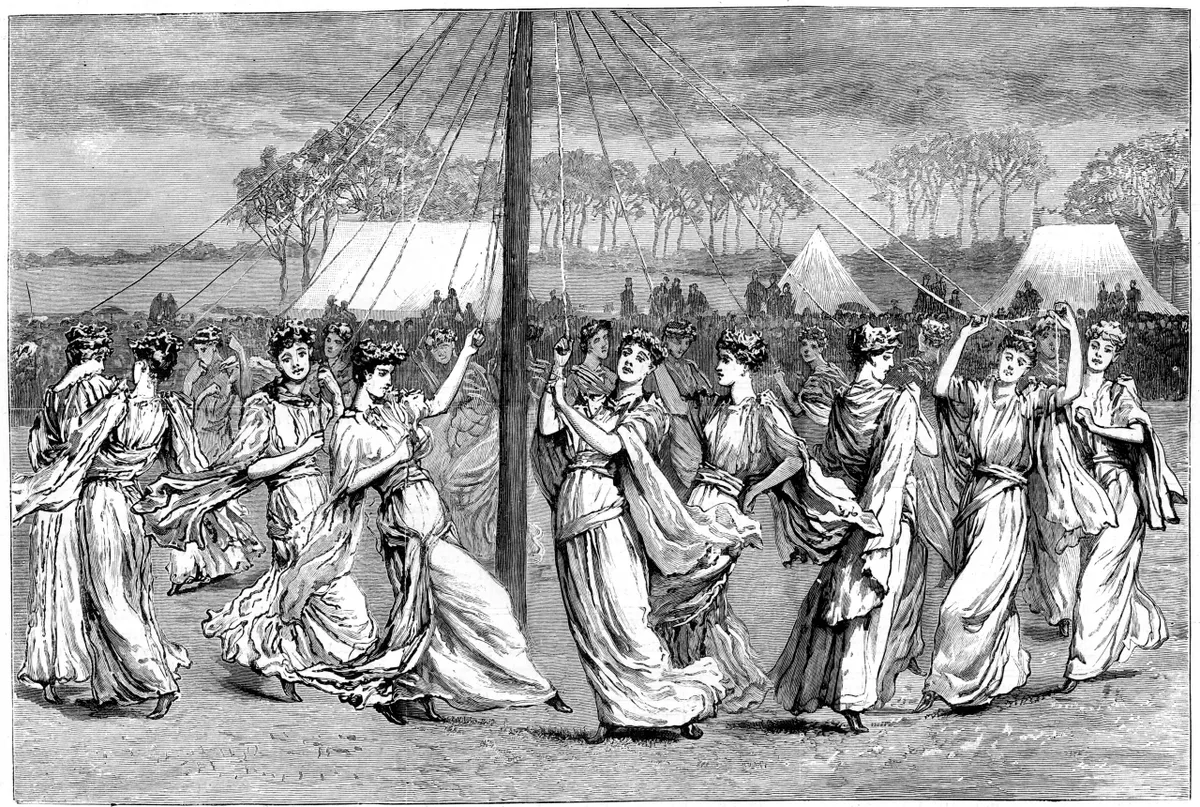Where did maypole dancing originate?
When maypole dancing takes place in English villages on the 1 May every year, the ribbon dances seem like an ancient tradition. However, modern-day maypole dancing was actually invented by the Victorians, based on ideas of a bygone ‘golden age’.
Like all good traditions, there is some discrepancy as to where maypole dancing originates. Some evidence suggests that it began in Roman Britain about 2,000 years ago, when soldiers celebrated the arrival of spring by dancing around decorated trees to thank the goddess Flora.
However, a link also exists between maypole dancing and pagan folklore. The ancient Celts divided their year into four festivals, the most significant of which was Beltane – the first day of summer. The day was marked by traditional fertility rites, and a tree would be selected, stripped of its branches, then decorated with flower garlands.
The earliest reference to a maypole appears in a 15th-century poem attributed to Geoffrey Chaucer called Chaunce of the Dice, where reference was made to the permanent maypole at Cornhill in London.
Why do we dance around the maypole?
Since May Day was often granted as a rest day to labourers in the Middle Ages, it is easy to imagine the potential for bawdy medieval revelry around the phallic symbol of the maypole. It was this image the Victorians were keen to clean up, sanitising it into the ‘rustic’ children’s dancing we see today.
The maypole also represented the sacred tree and its attendant spirits, who would bring a village good luck, but this often led to rival villages trying to remove each other’s poles.
The Derby Mercury in May 1772 reports one such incident in Leicestershire, where “a body of young fellows from Loughborough, who formed a plot to carry off the maypole, which they executed at night… may be the cause of mischief and bloodshed, for the heroes of Quarndon vow revenge and are forming alliances with their neighbours of Barrow and Sheepshead, and give out they will soon march in a body to retake their favourite maypole.”
When were ribbons added to the maypole?
The maypole was always the focal point of village dancing, but in its earliest incarnation the tradition involved no plaited ribbons.
Instead the maypole was brightly decorated with spring flowers, and surviving illustrations show adult dancers holding hands in a circle around the pole.
The first documented plaited-ribboned maypole appeared not on a village green, but on stage in JT Haine’s play Richard Plantagenet at the Victoria Theatre, London (the Old Vic), in 1836. This new interpretation of the maypole dance was copied across the country, with regional variances including ‘well-dressing’ in Buxton – the decoration of springs and wells with pictures made from natural materials – and a ‘Jack-in-the-Green’ in Cheshire, where a pyramid or conical framework was decorated with spring foliage and worn as part of the May Day procession.

When was maypole dancing banned?
The Protestant Reformation put an abrupt end to the drinking and dancing that accompanied May Day in the Middle Ages. In 1644 maypoles were banned altogether in an Act of Parliament under the 17th century Protectorship of Oliver Cromwell.
However, in 1660 the monarchy was restored and maypoles soon followed as ‘Merrie England’ was revived under Charles II.
Anthony Wood, a 17th-century Oxford diarist, recounts an incident in May 1660 where “a maypole... [was] set up on purpose to vex the Presbyterians and Independents”. According to Wood, attempts to saw it down were futile so it was left to stand as a symbol of Restoration triumph.
What is a May Queen?

Maypole dancing and the May Queen often went hand in hand. These ‘traditions’ both underwent a renaissance in the Victorian period, and were reimagined as the ultimate representation of rustic peasantry.
The idea of the May Queen, usually a young girl dressed in robes and ‘crowned’ as part of the festivities, gathered pace throughout the 19th century, fuelled by the Victorians’ remodelling of British customs. Poems such as Alfred Tennyson’s The May Queen (1833) and George Daniel’s Merrie England in the Olden Time (1842) advocated the maypole as a symbol of social unity.
In 1881 writer and artist John Ruskin was a guest at the May Queen ceremony at Whitelands, a Church of England teacher-training college in Roehampton.
The ceremony, where female students chose one of their number to be May Queen, was disseminated countrywide in village schools. Ironically, Ruskin was rather disparaging about the winner, writing to the Whitelands principal: “She looks to me between 35 and 38, and rather as if she would bring back the inquisition and trial by the rack.”
Accounts from this period suggest that maypole dancing and the crowning of the May Queen were often controlled by the village elite, rather than occurring as a result of village folk customs.